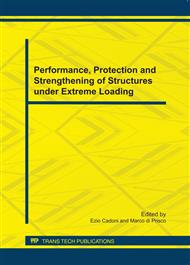p.539
p.545
p.551
p.559
p.565
p.571
p.577
p.583
p.589
Enhancing the Impact Resistance of Historical Stone Masonry Units with Fibre-Reinforced Hydraulic Lime Mortars
Abstract:
This paper describes the dynamic response of sandstone masonry units bound with fibre-reinforced mortars comparing a Portland cement-lime system with hydraulic lime. A drop-weight impact machine was used to generate stress rates up to 107 kPa/s. The dynamic impact factor and stress rate sensitivity were evaluated for the flexural strength of the sandstone and mortar, and for the bond strength of the unit, and further, the pattern of failure was noted in the units for each mortar mix and loading rate. Polypropylene microfibres were incorporated at 0%, 0.25% and 0.5% volume fraction into the mortar. Results show that the flexural bond strength was more sensitive to stress rate than the flexural strength of the mortar, at similar rates of loading. Further, the stress rate sensitivity of the bond strength decreased with an increase in the fibre content. Also, whereas the flexural toughness factors for the stone-mortar bond fell with fibre reinforcement in the stronger Portland cement-lime system, the bond improved with fibre addition when employing hydraulic lime mortar.
Info:
Periodical:
Pages:
565-570
Citation:
Online since:
July 2011
Authors:
Price:
Сopyright:
© 2011 Trans Tech Publications Ltd. All Rights Reserved
Share:
Citation:


